Cloud Database Migration Report: Database Implementation and Security
VerifiedAdded on 2023/06/07
|7
|1153
|79
Report
AI Summary
This report delves into the crucial aspects of cloud database migration, addressing the increasing prevalence of cloud computing and its impact on database deployment. It explores the significance of Database as a Service (DBaaS), highlighting its benefits such as simplicity, consistent performance, data syncing capabilities, and enhanced performance. The report outlines the scope breakdown structure for cloud database migration, including leveraging cloud databases, generating proof of concept, executing technical plans, and data migration processes. It also details the process of migration, from selecting migration types to ensuring security and scalability, emphasizing the challenges and considerations involved. The report concludes by stressing the importance of robust security measures and the influence of database size, complexity, and application usage on cloud database architecture and scalability.
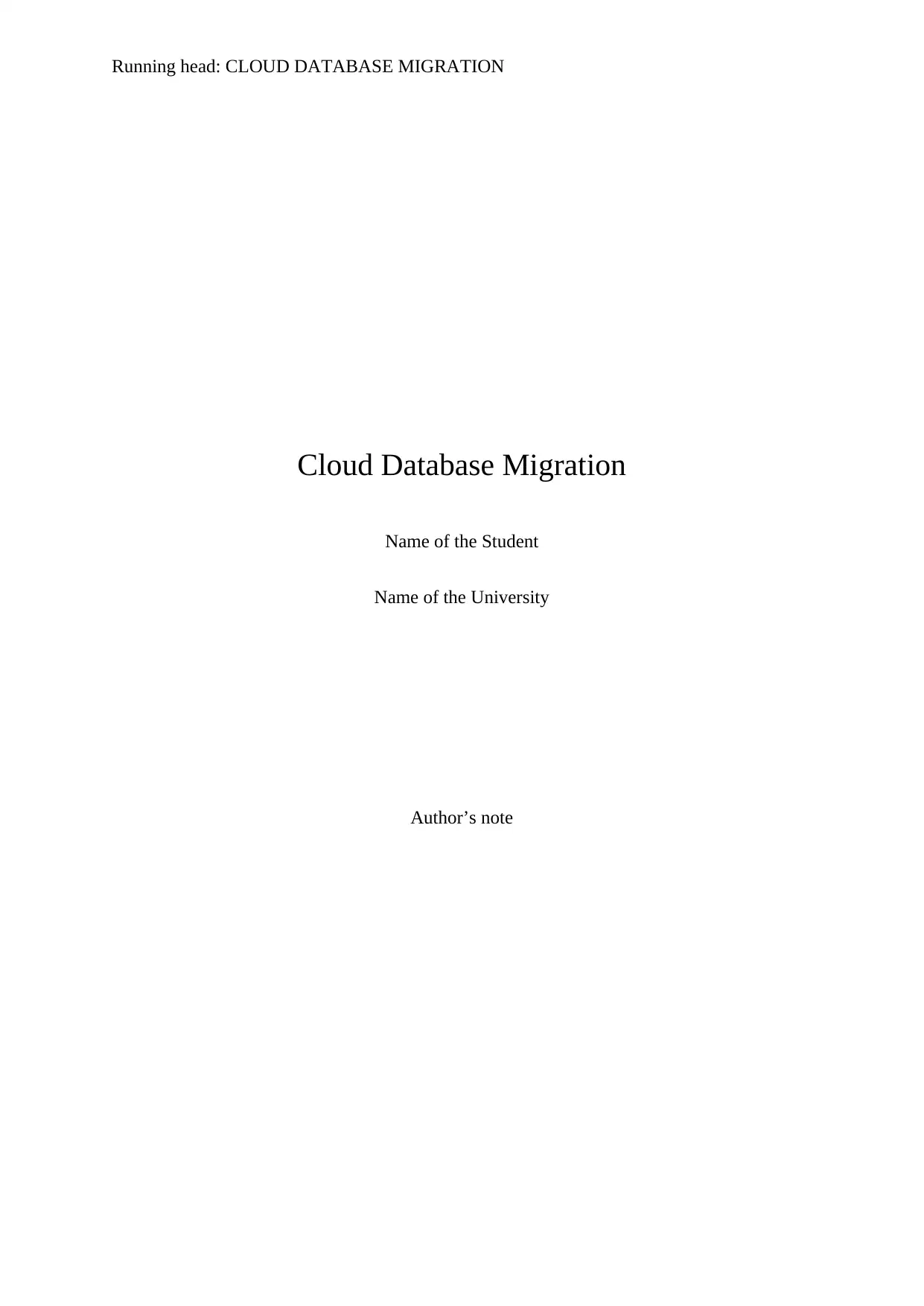
Running head: CLOUD DATABASE MIGRATION
Cloud Database Migration
Name of the Student
Name of the University
Author’s note
Cloud Database Migration
Name of the Student
Name of the University
Author’s note
Paraphrase This Document
Need a fresh take? Get an instant paraphrase of this document with our AI Paraphraser
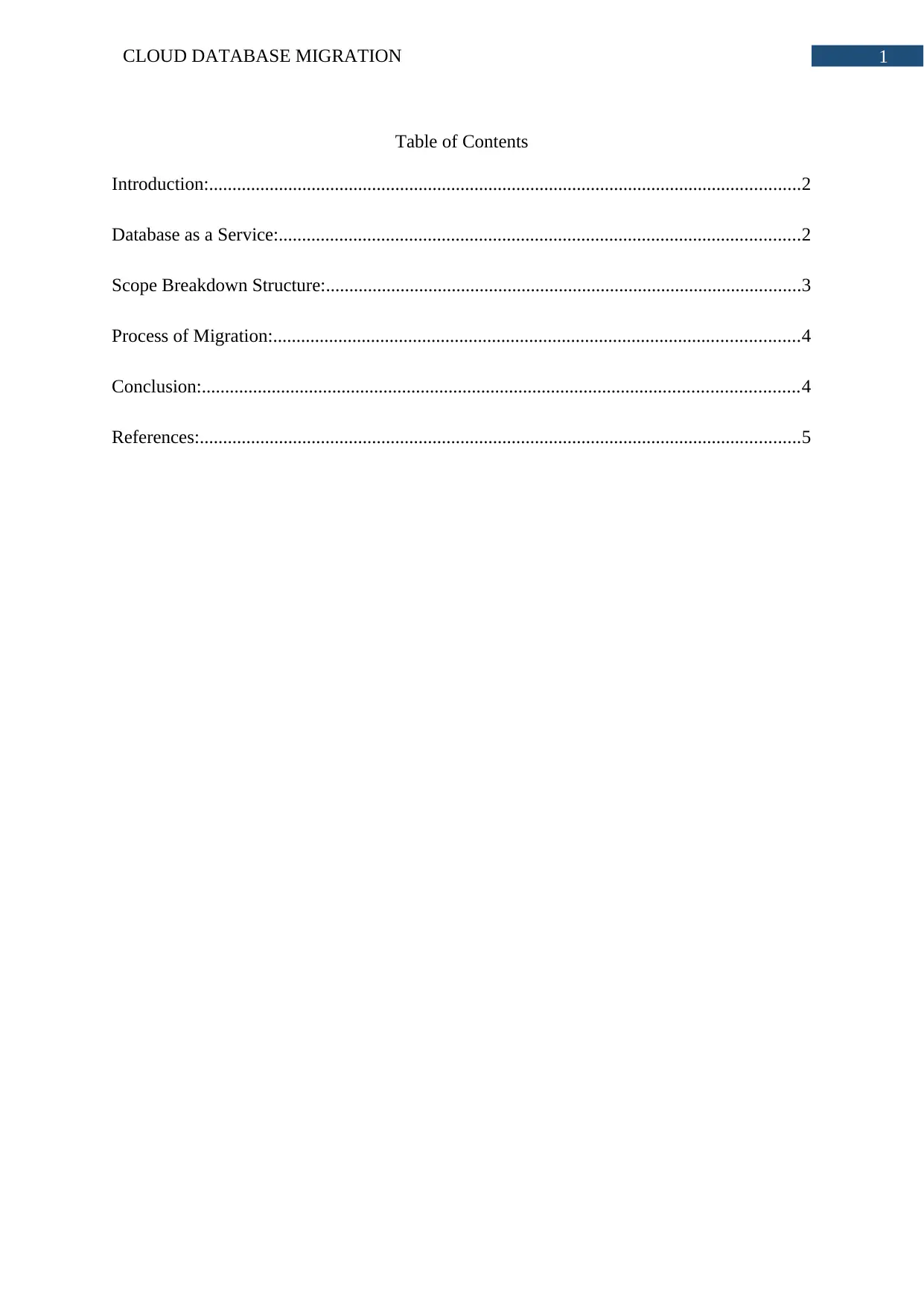
1CLOUD DATABASE MIGRATION
Table of Contents
Introduction:...............................................................................................................................2
Database as a Service:................................................................................................................2
Scope Breakdown Structure:......................................................................................................3
Process of Migration:.................................................................................................................4
Conclusion:................................................................................................................................4
References:.................................................................................................................................5
Table of Contents
Introduction:...............................................................................................................................2
Database as a Service:................................................................................................................2
Scope Breakdown Structure:......................................................................................................3
Process of Migration:.................................................................................................................4
Conclusion:................................................................................................................................4
References:.................................................................................................................................5
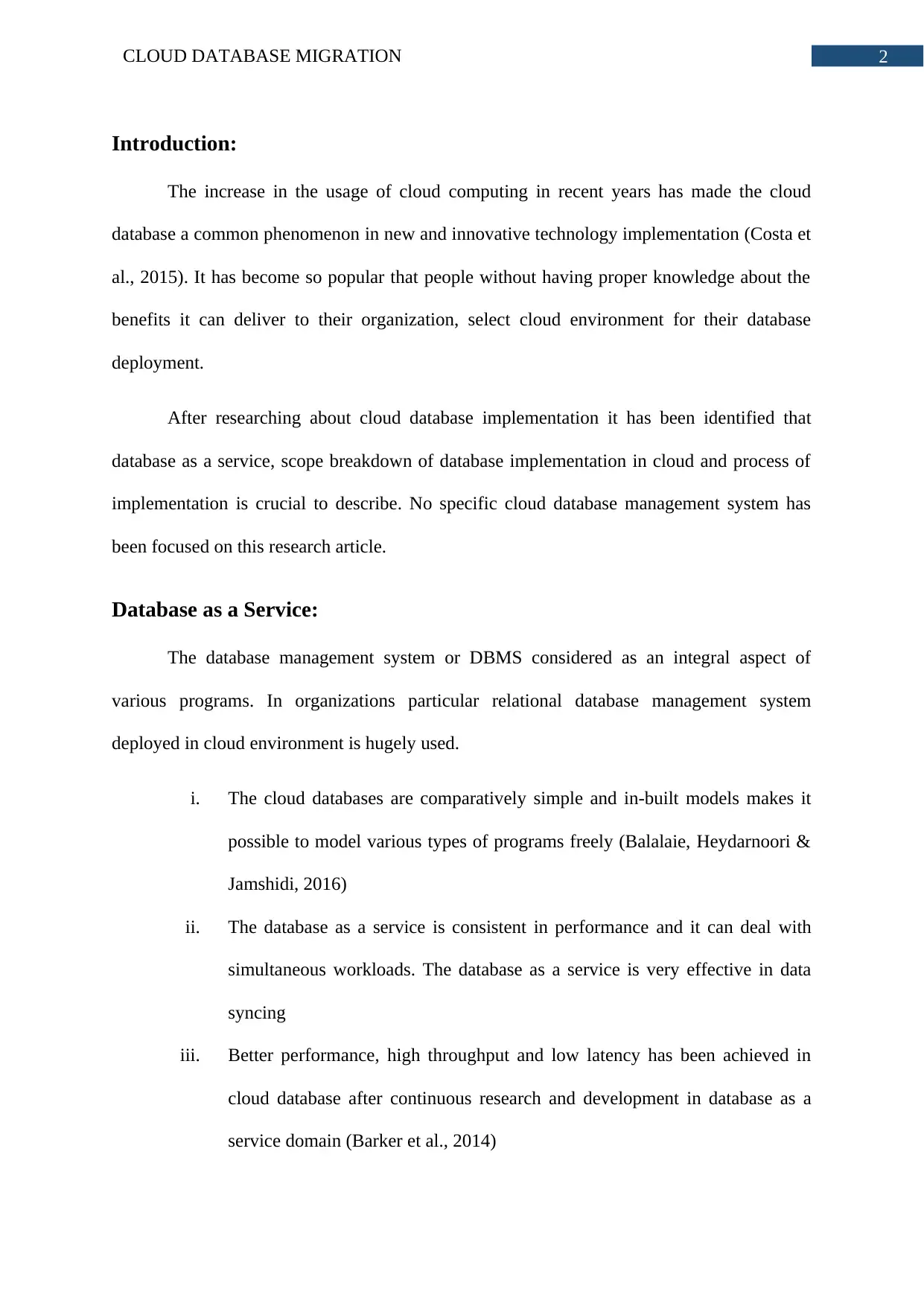
2CLOUD DATABASE MIGRATION
Introduction:
The increase in the usage of cloud computing in recent years has made the cloud
database a common phenomenon in new and innovative technology implementation (Costa et
al., 2015). It has become so popular that people without having proper knowledge about the
benefits it can deliver to their organization, select cloud environment for their database
deployment.
After researching about cloud database implementation it has been identified that
database as a service, scope breakdown of database implementation in cloud and process of
implementation is crucial to describe. No specific cloud database management system has
been focused on this research article.
Database as a Service:
The database management system or DBMS considered as an integral aspect of
various programs. In organizations particular relational database management system
deployed in cloud environment is hugely used.
i. The cloud databases are comparatively simple and in-built models makes it
possible to model various types of programs freely (Balalaie, Heydarnoori &
Jamshidi, 2016)
ii. The database as a service is consistent in performance and it can deal with
simultaneous workloads. The database as a service is very effective in data
syncing
iii. Better performance, high throughput and low latency has been achieved in
cloud database after continuous research and development in database as a
service domain (Barker et al., 2014)
Introduction:
The increase in the usage of cloud computing in recent years has made the cloud
database a common phenomenon in new and innovative technology implementation (Costa et
al., 2015). It has become so popular that people without having proper knowledge about the
benefits it can deliver to their organization, select cloud environment for their database
deployment.
After researching about cloud database implementation it has been identified that
database as a service, scope breakdown of database implementation in cloud and process of
implementation is crucial to describe. No specific cloud database management system has
been focused on this research article.
Database as a Service:
The database management system or DBMS considered as an integral aspect of
various programs. In organizations particular relational database management system
deployed in cloud environment is hugely used.
i. The cloud databases are comparatively simple and in-built models makes it
possible to model various types of programs freely (Balalaie, Heydarnoori &
Jamshidi, 2016)
ii. The database as a service is consistent in performance and it can deal with
simultaneous workloads. The database as a service is very effective in data
syncing
iii. Better performance, high throughput and low latency has been achieved in
cloud database after continuous research and development in database as a
service domain (Barker et al., 2014)
⊘ This is a preview!⊘
Do you want full access?
Subscribe today to unlock all pages.

Trusted by 1+ million students worldwide

3CLOUD DATABASE MIGRATION
iv. The cloud database are highly reliable because of persistence of data through
maintaining data safety at occurrence of various failures
The manual method for administration of database is not feasible for database cloud-
computing as it is consisted of thousands of servers that have data centres incorporated within
those. The database as a service of Google, Microsoft and Amazon compute hundred and
thousands of nodes. These nodes can be used by numerous applications for achieving
unparalleled economics-of-sales (Rai, Mehfuz & Sahoo, 2018). These three organizations are
constantly improving their Database as a Service so that scalability, load distribution and
elasticity can be achieved in terms of self-management or layer autonomic.
Scope Breakdown Structure:
The breakdown structure, a project management tool, is utilized by all the
organizations for organizing the deliverables of the project (Balalaie, Heydarnoori &
Jamshidi, 2016). These deliverable are managed in hierarchical way through breakdown
structure. The scope of Migrating Database to cloud are as following.
i. Leveraging and testing cloud database
ii. Generating the concept proof
iii. Providing support to the organization and managing cloud
iv. Executing technical plans
v. Data migration process execution
vi. Generating documents
vii. Providing training to users and administrators
viii. Optimizing and monitoring the database
ix. Switch over operation to the cloud
iv. The cloud database are highly reliable because of persistence of data through
maintaining data safety at occurrence of various failures
The manual method for administration of database is not feasible for database cloud-
computing as it is consisted of thousands of servers that have data centres incorporated within
those. The database as a service of Google, Microsoft and Amazon compute hundred and
thousands of nodes. These nodes can be used by numerous applications for achieving
unparalleled economics-of-sales (Rai, Mehfuz & Sahoo, 2018). These three organizations are
constantly improving their Database as a Service so that scalability, load distribution and
elasticity can be achieved in terms of self-management or layer autonomic.
Scope Breakdown Structure:
The breakdown structure, a project management tool, is utilized by all the
organizations for organizing the deliverables of the project (Balalaie, Heydarnoori &
Jamshidi, 2016). These deliverable are managed in hierarchical way through breakdown
structure. The scope of Migrating Database to cloud are as following.
i. Leveraging and testing cloud database
ii. Generating the concept proof
iii. Providing support to the organization and managing cloud
iv. Executing technical plans
v. Data migration process execution
vi. Generating documents
vii. Providing training to users and administrators
viii. Optimizing and monitoring the database
ix. Switch over operation to the cloud
Paraphrase This Document
Need a fresh take? Get an instant paraphrase of this document with our AI Paraphraser
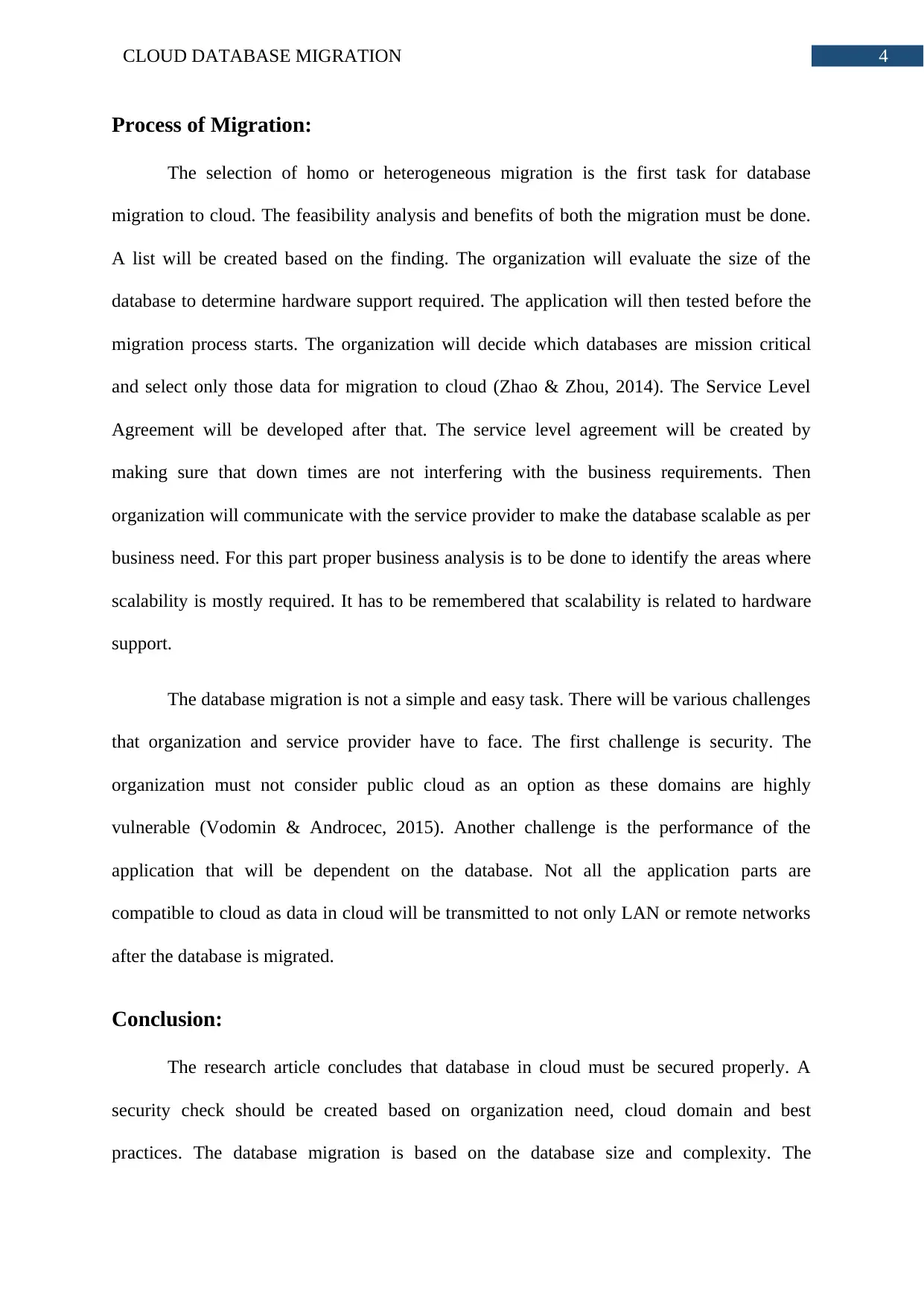
4CLOUD DATABASE MIGRATION
Process of Migration:
The selection of homo or heterogeneous migration is the first task for database
migration to cloud. The feasibility analysis and benefits of both the migration must be done.
A list will be created based on the finding. The organization will evaluate the size of the
database to determine hardware support required. The application will then tested before the
migration process starts. The organization will decide which databases are mission critical
and select only those data for migration to cloud (Zhao & Zhou, 2014). The Service Level
Agreement will be developed after that. The service level agreement will be created by
making sure that down times are not interfering with the business requirements. Then
organization will communicate with the service provider to make the database scalable as per
business need. For this part proper business analysis is to be done to identify the areas where
scalability is mostly required. It has to be remembered that scalability is related to hardware
support.
The database migration is not a simple and easy task. There will be various challenges
that organization and service provider have to face. The first challenge is security. The
organization must not consider public cloud as an option as these domains are highly
vulnerable (Vodomin & Androcec, 2015). Another challenge is the performance of the
application that will be dependent on the database. Not all the application parts are
compatible to cloud as data in cloud will be transmitted to not only LAN or remote networks
after the database is migrated.
Conclusion:
The research article concludes that database in cloud must be secured properly. A
security check should be created based on organization need, cloud domain and best
practices. The database migration is based on the database size and complexity. The
Process of Migration:
The selection of homo or heterogeneous migration is the first task for database
migration to cloud. The feasibility analysis and benefits of both the migration must be done.
A list will be created based on the finding. The organization will evaluate the size of the
database to determine hardware support required. The application will then tested before the
migration process starts. The organization will decide which databases are mission critical
and select only those data for migration to cloud (Zhao & Zhou, 2014). The Service Level
Agreement will be developed after that. The service level agreement will be created by
making sure that down times are not interfering with the business requirements. Then
organization will communicate with the service provider to make the database scalable as per
business need. For this part proper business analysis is to be done to identify the areas where
scalability is mostly required. It has to be remembered that scalability is related to hardware
support.
The database migration is not a simple and easy task. There will be various challenges
that organization and service provider have to face. The first challenge is security. The
organization must not consider public cloud as an option as these domains are highly
vulnerable (Vodomin & Androcec, 2015). Another challenge is the performance of the
application that will be dependent on the database. Not all the application parts are
compatible to cloud as data in cloud will be transmitted to not only LAN or remote networks
after the database is migrated.
Conclusion:
The research article concludes that database in cloud must be secured properly. A
security check should be created based on organization need, cloud domain and best
practices. The database migration is based on the database size and complexity. The

5CLOUD DATABASE MIGRATION
applications that will use the database also determines the cloud database architecture and
scalability.
applications that will use the database also determines the cloud database architecture and
scalability.
⊘ This is a preview!⊘
Do you want full access?
Subscribe today to unlock all pages.

Trusted by 1+ million students worldwide
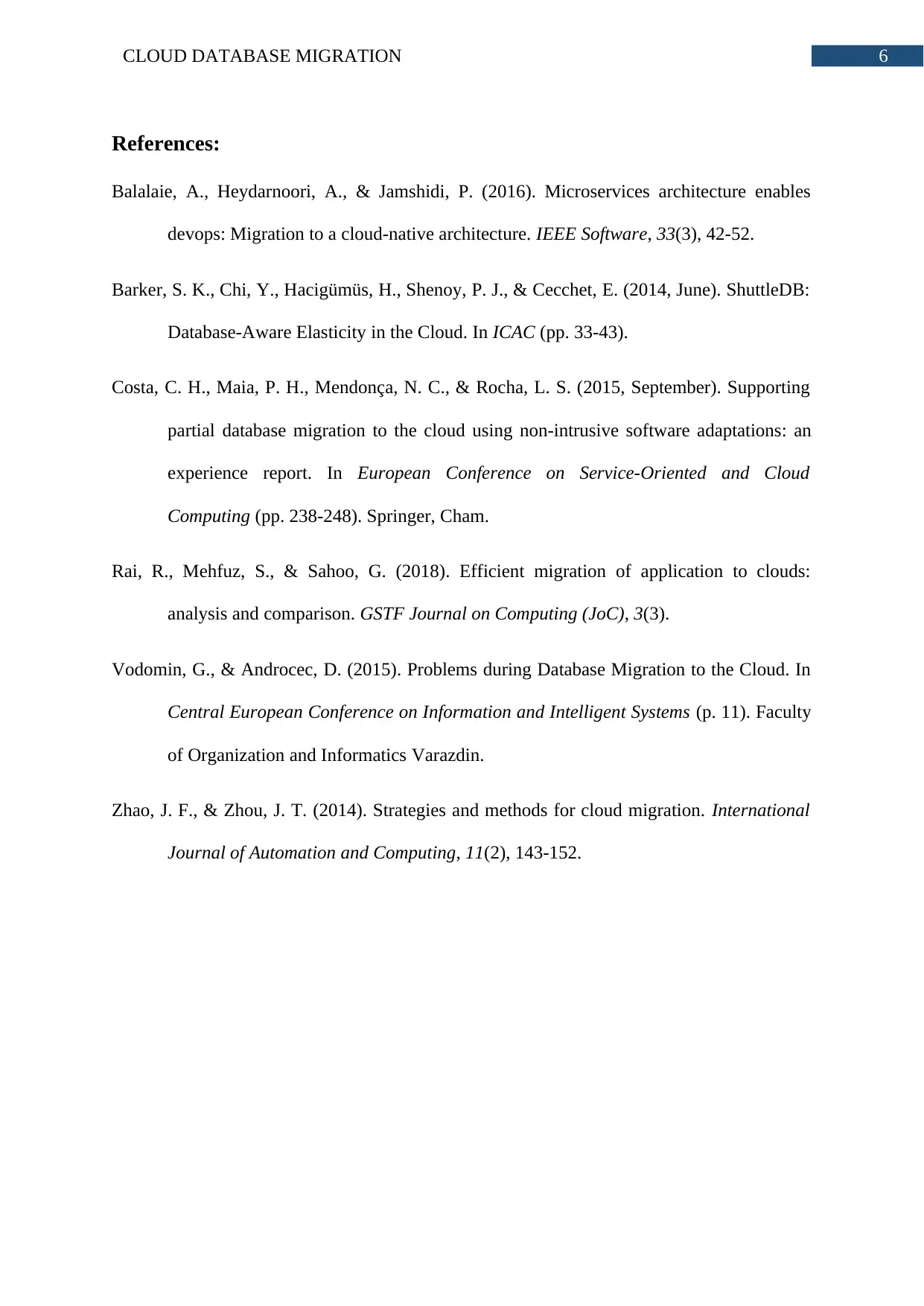
6CLOUD DATABASE MIGRATION
References:
Balalaie, A., Heydarnoori, A., & Jamshidi, P. (2016). Microservices architecture enables
devops: Migration to a cloud-native architecture. IEEE Software, 33(3), 42-52.
Barker, S. K., Chi, Y., Hacigümüs, H., Shenoy, P. J., & Cecchet, E. (2014, June). ShuttleDB:
Database-Aware Elasticity in the Cloud. In ICAC (pp. 33-43).
Costa, C. H., Maia, P. H., Mendonça, N. C., & Rocha, L. S. (2015, September). Supporting
partial database migration to the cloud using non-intrusive software adaptations: an
experience report. In European Conference on Service-Oriented and Cloud
Computing (pp. 238-248). Springer, Cham.
Rai, R., Mehfuz, S., & Sahoo, G. (2018). Efficient migration of application to clouds:
analysis and comparison. GSTF Journal on Computing (JoC), 3(3).
Vodomin, G., & Androcec, D. (2015). Problems during Database Migration to the Cloud. In
Central European Conference on Information and Intelligent Systems (p. 11). Faculty
of Organization and Informatics Varazdin.
Zhao, J. F., & Zhou, J. T. (2014). Strategies and methods for cloud migration. International
Journal of Automation and Computing, 11(2), 143-152.
References:
Balalaie, A., Heydarnoori, A., & Jamshidi, P. (2016). Microservices architecture enables
devops: Migration to a cloud-native architecture. IEEE Software, 33(3), 42-52.
Barker, S. K., Chi, Y., Hacigümüs, H., Shenoy, P. J., & Cecchet, E. (2014, June). ShuttleDB:
Database-Aware Elasticity in the Cloud. In ICAC (pp. 33-43).
Costa, C. H., Maia, P. H., Mendonça, N. C., & Rocha, L. S. (2015, September). Supporting
partial database migration to the cloud using non-intrusive software adaptations: an
experience report. In European Conference on Service-Oriented and Cloud
Computing (pp. 238-248). Springer, Cham.
Rai, R., Mehfuz, S., & Sahoo, G. (2018). Efficient migration of application to clouds:
analysis and comparison. GSTF Journal on Computing (JoC), 3(3).
Vodomin, G., & Androcec, D. (2015). Problems during Database Migration to the Cloud. In
Central European Conference on Information and Intelligent Systems (p. 11). Faculty
of Organization and Informatics Varazdin.
Zhao, J. F., & Zhou, J. T. (2014). Strategies and methods for cloud migration. International
Journal of Automation and Computing, 11(2), 143-152.
1 out of 7
Related Documents
Your All-in-One AI-Powered Toolkit for Academic Success.
+13062052269
info@desklib.com
Available 24*7 on WhatsApp / Email
![[object Object]](/_next/static/media/star-bottom.7253800d.svg)
Unlock your academic potential
Copyright © 2020–2025 A2Z Services. All Rights Reserved. Developed and managed by ZUCOL.




